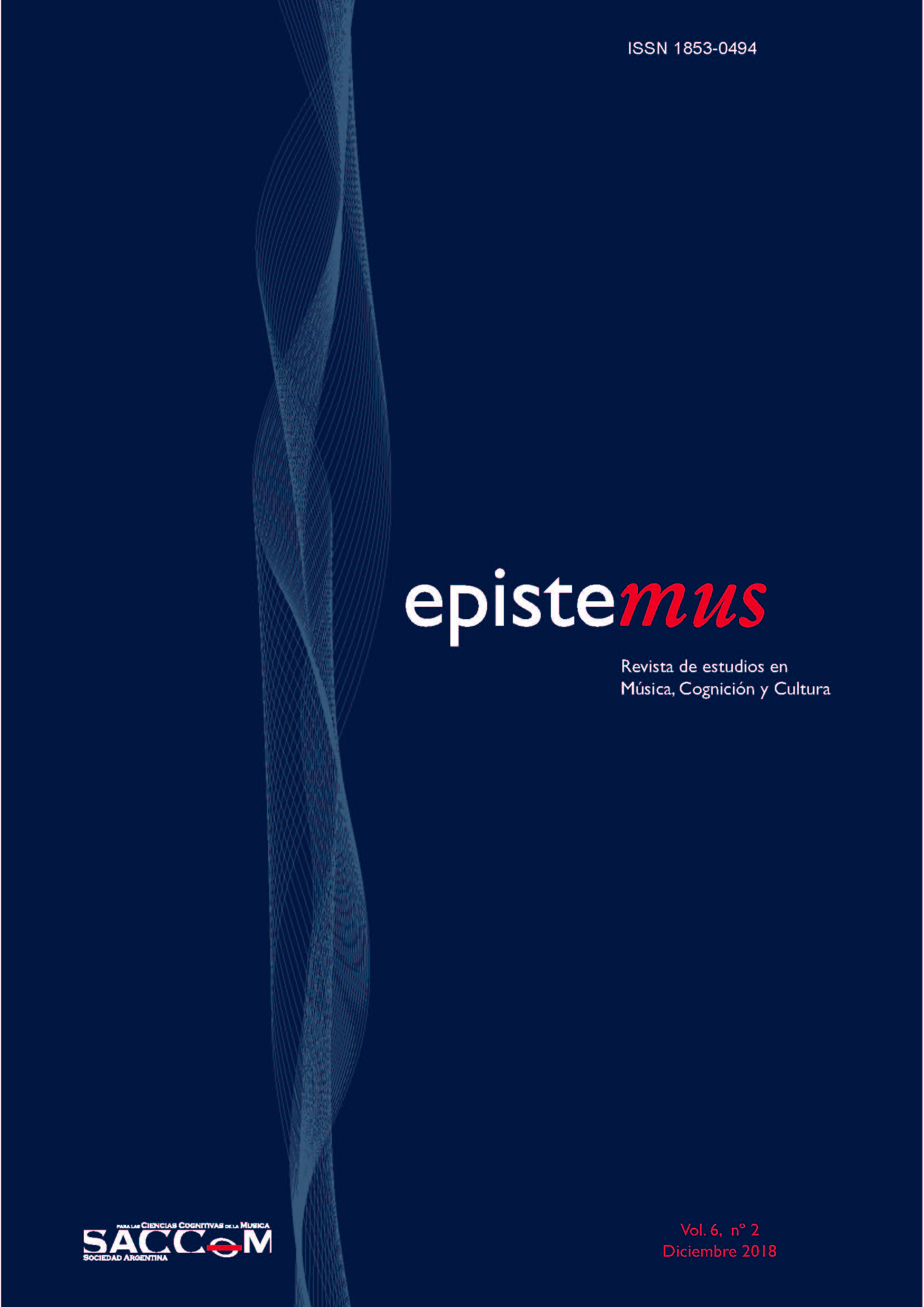Musical interpersonal time shaping at the orchestral line
DOI:
https://doi.org/10.24215/18530494e016Keywords:
expressive performance, interpersonal aligment, variability, adaptive timing, leader/followerAbstract
This work studies the temporal construction of a musical fragment in a spontaneous reinterpretation trail in the orchestra row. Three orchestral row violists were summoned to assemble live a 13-bar musical fragment from the introductory section of Paul Hindemith´s 3rd movement “Mathis der Maler”, in which the string orchestra plays in unison and eighths. Once the task is completed, the performers resolve to spontaneously replay the final section corresponding to the cadence and closure of the fragment. The horizontal and vertical variability of the time intervals between sound attacks (IOI) was analyzed comparatively between the initial version and the reinterpretation of the above-mentioned end. The analysis of the interaction between performers was approached based on the notions of leader / follower. The results show a high-level synchronization between interpreters in both versions. Differences in the IOIs between versions show an active participation of the violists to achieve a unison sound, regardless of the assigned guide / follower roles. Notably, the temporal variability between performers was minimized at metric structural locations, while, at the same time the synchrony between performers increased. Alignment behind the leader voice cohabit metrical anchoring as a way of organizing performance. As emerges from the interviews carried out, the univocal temporal construction in an orchestra row suggests a continuous and interdependent action of moment-by-moment micro-adjustments and compensations, adapting performance both to the leader's voice and to each other. It includes the flexible, dynamic, and collaborative behavior of the guide, who actively participates in the common objective.
Downloads
Metrics
References
Clarke, E. F. (2014). Lost and found in music: consciousness and subjectivity. Musicae Scienciae 18(3), 354-368. doi: 10.1177/1029864914533812
De Jaegher, H. y Di Paolo, E. A. (2007). Participatory sense-making: an active approach to social cognition. Phenomenology and the Cognitive Sciences, 6(4), 485-507. doi: 10.1007/s11097-007-9076-9
Español, S. y Shifres, F. (2015). The artistic infant directed performance: a microanalysis of the adult’s movements and sounds. Integrative Psychological and Behavioral Science, 49(3) 371-397. doi: 10.1007/s12124-015-9308-4
Goebl, W. y Palmer, C. (2009). Synchronization of timing and motion among performing musicians. Music Perception, 26, 427-438. doi: 10.1525/mp.2009.26.5.427
Goebl, W. y Parncutt, R. (2002). The influence of the relative intensity on the perception of onset asynchronies. Proceedings of the 7th International Conference on Music Perception and Cognition (ICMPC, 2002). Sydney, Australia.
Goodman, E. (2002). Ensemble performance. En J. Rink (Ed.), Musical Performance: A Guide to Understanding (pp.153-167). Cambridge: Cambridge University Press.
Keller, P. E. (2008). Joint action in music performance. En F. Morganti, A. Carassa y G. Riva (Eds.), Enacting Intersubjetivity: A Cogntive and Social Perspective on the Study of Interactions (pp. 205-211). Amsterdam: IOS Press.
Keller, P. E. (2014). Ensemble performance: interpersonal alignment of musical expression. En D. Fabian, R. Timmers y E. Schubert (Eds.), Expressiveness in music performance: Empirical approaches across styles and cultures (pp. 260-282). Oxford: Oxford University Press.
Keller, P. E. y Appel, M. (2010). Individual differences, auditory imaginery, and the coordination of body movements and sounds in musical ensembles. Music Perception, 28(1), 27-46. doi: 10.1525/mp.2010.28.1.27
Large, E. W. y Palmer, C. (2002). Perceiving temporal regularity in music. Cognitive Science, 26(1), 1-37. doi: 10.1207/s15516709cog2601_1
Leman, M. (2016). The Expressive Moment. How Interaction (with Music) Shapes Human Empowerment. Cambridge, Massachusetts : MIT Press.
Lerdahl, F. y Jackendoff, R. (1983). A Generative Theory of Tonal Music. Cambridge, Massachusetts: The MIT Press.
Madison, G., Ullén, F. y Merker, B. (2017). Metrically structured time and entrainment. En M. Lesaffre, P. J. Maes y M. Leman (Eds.), The Routledge Companion to Embodied Music Interaction (pp. 22-30). Nueva York: Routledge.
Malloch, S. y Trevarthen, C. (Eds.). (2009). Communicative Musicality. Oxford: Oxford University Press.
Martínez, I. C. (2014). La base corporeizada del significado musical. En S. Español (Ed.) Psicología de la Música y del Desarrollo (pp. 71-110). Buenos Aires: Paidós.
Palmer, C. (1997). Music performance. Annual Review of Psychology, 48, 115-138. doi: 10.1146/annurev.psych.48.1.115
Rankin, S. K., Large, E. W. y Fink. P. W. (2009). Fractal tempo fluctuation and pulse prediction. Music Perception, 26(5), 401-413. doi: 10.1525/mp.2009.26.5.401
Rasch, R. A. (1979). Synchronization in performed ensemble music. Acustica, 43(2), 121-131.
Repp, B. H. (2010). Self-generated interval subdivision reduces variability of synchronization with a very slow metronome. Music Perception, 27(5), 389-397. doi: 10.1525/mp.2010.27.5.389
Shaffer, L. H. (1984). Timing in solo and duet piano performance. Quarterly Journal of Experimental Psychology, 36, 577-595. doi: 10.1080/14640748408402180
Sawyer, K. (2006). Group creativity: musical performance and collaboration. Psychology of Music, 34(2), 148-165. doi: 10.1177/0305735606061850
Tecumseh Fitch, W. (2012). The biology and evolution of rhythm: unravelling a paradox. En P. Rebuschat, M. Rohrmeier, J. A. Hawkins e I. Cross (Eds). Language and Music as Cognitive Systems (pp. 73-94). Oxford: Oxford University Press.
Timmers, R., Endo, S., Bradbury, A. y Wing, A. M. (2014). Synchronization and leadership in string quartet performance: a case study of auditory and visual cues. Frontiers in Psychology, 5(645). doi: 10.3389/fpsyg.2014.00645
Todd, N. (1985). A model of expressive timing in tonal music. Music Perception, 3(1), 33–57. doi: 10.2307/40285321
Varni, G., Volpe, G. y Camurri, A. (2010). A system for real-time multimodal analysis of nonverbal affective social interaction in user-centric media. IEEE Transactions on Multimedia, 12, 576-590. doi: 10.1109/TMM.2010.2052592
Downloads
Published
How to Cite
Issue
Section
License
Politica vigente desde octubre de 2019
La aceptación del manuscrito por parte de la revista implica la cesión no exclusiva de los derechos patrimoniales de los/as autores/as en favor del editor, quien permite la reutilización, luego de su edición (postprint), bajo una Licencia Creative Commons Atribución-NoComercial-CompartirIgual 4.0 Internacional (CC BY-NC-SA 4.0)
Acorde a estos términos, el material se puede copiar y redistribuir en cualquier medio o formato siempre que a) se cite la autoría y la fuente original de su publicación (revista y URL de la obra), se brinde el acceso a la licencia y se indique si se realizaron cambios; b) no se utilice el material para fines comerciales.
La cesión de derechos no exclusivos implica que luego de su edición (postprint) en Epistemus los/as autores/as pueden publicar su trabajo en cualquier idioma, medio y formato; en tales casos, se solicita que se consigne que el material fue publicado originalmente en esta revista.
Tal cesión supone, también, la autorización de los/as autores/as para que el trabajo sea cosechado por SEDICI, el repositorio institucional de la Universidad Nacional de La Plata, y sea difundido en las bases de datos que el equipo editorial considere adecuadas para incrementar la visibilidad de la publicación y de sus autores/as.
Asimismo, la revista incentiva a los/as autores/as para que luego de su publicación en Epistemus depositen sus producciones en otros repositorios institucionales y temáticos, bajo el principio de que ofrecer a la sociedad la producción científica y académica sin restricciones contribuye a un mayor intercambio del conocimiento global.

















